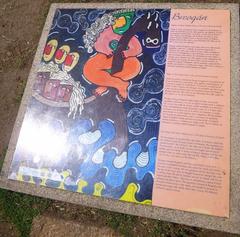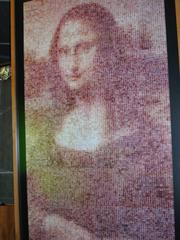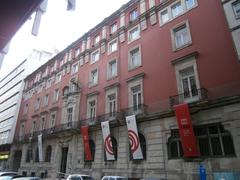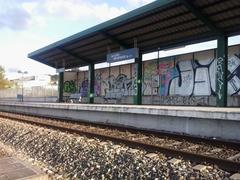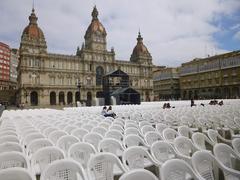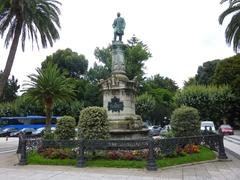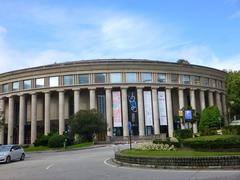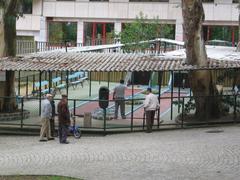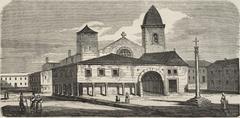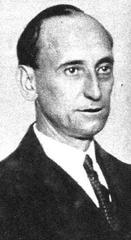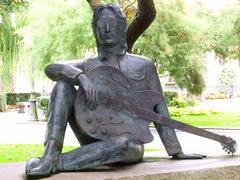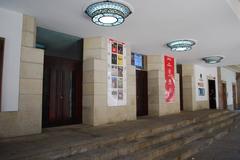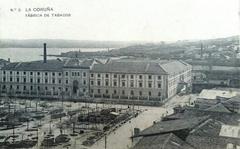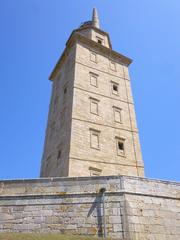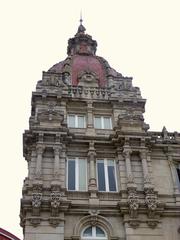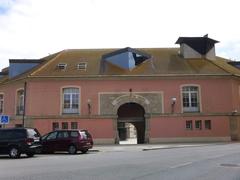
Iglesia Castrense de San Andrés: Visiting Hours, Tickets, and Travel Guide in A Coruña, Spain
Date: 04/07/2025
Introduction
Nestled in the heart of A Coruña, the Iglesia Castrense de San Andrés stands as a living testament to the city’s maritime roots and military traditions. From its founding by the Cofradía de Mareantes y Pescadores in the 13th century to its current role as the garrison church for the Spanish Armed Forces, the church’s history embodies the convergence of faith, community, and national service (La Voz de Galicia; Qué hacer en Coruña).
This guide provides a comprehensive overview, including historical context, architectural highlights, religious and social significance, up-to-date visiting hours, ticket policies, accessibility, visitor tips, and nearby attractions. Whether you are a history enthusiast, cultural traveler, pilgrim, or simply curious, this resource is designed to enrich your experience at one of A Coruña’s most emblematic sites.
Historical Overview
Origins as a Mariner’s Chapel
The story of Iglesia Castrense de San Andrés begins in the 13th century, when local mariners and fishermen established a chapel dedicated to Saint Andrew—patron of fishermen—at a time when the Orzán beach reached the church’s current location. This original chapel served as both a spiritual haven and a social center for the seafaring community. An adjacent hospital once cared for mariners, though it disappeared after the English invasion (La Voz de Galicia).
Transformation and Reconstruction
By the late 19th century, the original chapel had deteriorated beyond use. Philanthropist Eusebio da Guarda financed its reconstruction (1881–1884) in a neorrománico style, introducing a single-nave layout divided into five sections, a narthex, and a semicircular apse. The new church’s grandeur led to legal disputes over its ownership, but it ultimately remained a public religious space (Qué hacer en Coruña).
Transition to Military Church
In the 20th century, after a decree stripped local brotherhoods of their legal status, the church passed to the Archdiocese of Santiago. During the Spanish Civil War, it was officially designated a “castrense” church for the armed forces— a status it retains today. Despite its military association, the church remains open to the wider community, hosting both religious and civic events (Ministerio de Defensa; Ayuntamiento de A Coruña).
Architectural and Artistic Heritage
Exterior Features
The church’s neorrománico façade is marked by sobriety and dignity, constructed from local granite that seamlessly integrates with A Coruña’s historic streetscape. A single bell tower rises above the main entrance, and military insignia and commemorative plaques subtly signal its unique status (Paxinas Galegas).
Interior Design
Inside, a single nave leads to the sanctuary, flanked by pilasters and arches that evoke order and solemnity. The sanctuary features sacred art—retablos, statues, paintings—and military regalia. Commemorative plaques honor soldiers and major historical events, underscoring the dual religious and military heritage (Iglesias Locales).
Key Features:
- Modest altarpiece with iconography of St. Andrew and military symbols
- Stained glass and side chapels depicting saints and Spanish military history
- Stone and wood craftsmanship using regional materials
Religious Role and Community Impact
The Iglesia Castrense de San Andrés serves as both a parish church and a spiritual center for the military in A Coruña. It hosts daily and special Masses, sacraments, and memorial services for fallen soldiers. Military traditions—such as processions on patron saints’ days—blend with broader religious observance (Arzobispado Castrense de España). The church is also a hub for community outreach, offering support to military families and organizing charitable initiatives.
Integration with Civic and Cultural Life
Despite its military designation, the church actively participates in A Coruña’s civic festivals, including Semana Santa and Corpus Christi, fostering interaction between military and civilian populations. Its proximity to landmarks such as the Torre de Hércules, Plaza de María Pita, and the historic port makes it a natural starting point for exploring the city (Turismo de A Coruña).
Visiting Hours, Tickets, and Accessibility
Opening Hours (as of July 2025)
- Monday to Saturday: 10:00–13:00 and 17:00–20:00
- Sunday and Religious Holidays: 09:00–14:00
Note: Hours may vary for religious holidays, military ceremonies, or special events. Always check the official parish website or municipal site for updates.
Admission
- Free entry for all visitors. Donations are welcome to support church maintenance and restoration.
- Guided tours are not offered regularly, but may be available during cultural events or by prior arrangement.
Accessibility
- The main entrance has a short flight of steps and currently lacks a wheelchair ramp; however, assistance can often be arranged in advance.
- Wide aisles and seating are available inside, though some side chapels have narrow access.
- No restrooms on site; public facilities are available nearby at Plaza de María Pita.
Visitor Guidelines and Etiquette
- Dress modestly: Shoulders and knees should be covered.
- Maintain silence during services and private prayer.
- Photography: Permitted without flash or tripods; professional shoots require parish permission.
- Respect ceremonies: Military or religious events may restrict visitor access.
- Contact in advance for group visits or special arrangements.
Travel and Location Information
- Address: Rúa San Andrés, 47, 15003 A Coruña
- Getting there: Walkable from Plaza de María Pita (600m). Accessible via bus lines 3, 3A, 7 (Tranvías de A Coruña). Public parking at Plaza de Pontevedra and Obelisco.
- Safety: Central, well-patrolled area. Exercise normal precautions during busy events.
Nearby Attractions
- Plaza de María Pita: Main square with City Hall and cafés
- Museo de Bellas Artes: Leading fine arts museum, 400m away
- Praza de Lugo Market: Local produce and seafood
- Paseo Marítimo: Scenic seaside promenade
- Tower of Hercules: UNESCO World Heritage lighthouse
Special Events and Services
- Mass Times: Weekdays 10:30 and 19:00; Sundays and Holy Days 10:30, 12:00, and 19:00
- Military ceremonies may affect public access; check parish calendar before visiting (Parish Calendar).
- Cultural events: Guided visits available during “Noite Branca” and “Jornadas Europeas de Patrimonio”
Visitor Tips
- Plan ahead: Confirm visiting hours before arrival.
- Arrive early for Mass or ceremonies (limited seating).
- Explore the area: Make the most of the church’s central location.
- Use the Audiala app for guided tours and real-time updates.
Photography and Visuals
Personal photography is welcome when it does not disturb worshippers. The church’s blend of neorrománico architecture, military insignia, and historic interiors provides rich opportunities for memorable photos. Professional or group shoots require prior authorization.
Alt text: Exterior view of Iglesia Castrense de San Andrés, a historic church in A Coruña.
Language and Communication
Spanish and Galician are the main languages; English is limited. The city’s tourist office at Plaza de María Pita can assist with English-language information. Translation apps or hiring a local guide are recommended for non-Spanish speakers.
COVID-19 and Health Protocols
As of July 2025, most restrictions have been lifted. Hand hygiene and respectful distancing are encouraged, especially during crowded events. Masks are recommended for vulnerable individuals. For the latest updates, consult the Spanish Ministry of Health.
Frequently Asked Questions (FAQ)
Q: Are there admission fees or tickets required?
A: Entry is free; donations are appreciated.
Q: What are the visiting hours?
A: Monday to Saturday 10:00–13:00 and 17:00–20:00, Sundays and holidays 09:00–14:00.
Q: Is the church wheelchair accessible?
A: The entrance has steps; assistance can be arranged in advance.
Q: Can I take photos inside?
A: Yes, without flash or tripods. Professional shoots need permission.
Q: Are guided tours available?
A: Not regularly, but during special events or by arrangement.
Summary and Final Tips
The Iglesia Castrense de San Andrés is a unique destination reflecting the historical and cultural tapestry of A Coruña. Its evolution from fishermen’s chapel to military church is evident in its architecture, art, and active community role. Free and centrally located, it is ideal for visitors interested in history, architecture, faith, and local culture.
- Visit during weekday mornings for a quieter experience.
- Respect the sacred environment and guidelines for visitors.
- Use the church as a starting point to explore A Coruña’s historic quarter and seafront.
- Download the Audiala app and check official websites for the latest updates and event information.
Official Sources and Further Reading
- La Voz de Galicia, 2004, Cofradía de Mareantes y Pescadores History
- Qué hacer en Coruña, 2021, Iglesia Castrense de San Andrés Architecture
- Ayuntamiento de A Coruña, Equipamiento Cultural: Iglesia Castrense de San Andrés
- Ministerio de Defensa, Spain, Military Religious Services
- Arzobispado Castrense de España, Liturgical Information
- Turismo de Galicia, Pilgrimage and Cultural Tourism
- Turismo de A Coruña, Visitor Information








